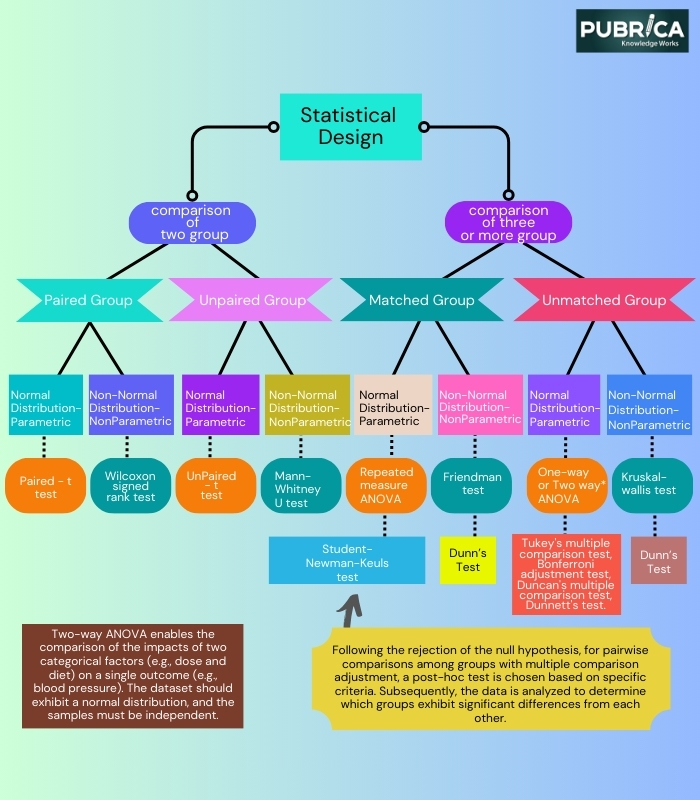
Good Withdrawal Letter: A Guide for Journal Submissions
February 1, 2024
Data Extraction and Bias Assessment with CHARMS & PROBAST
February 20, 2024Advanced Statistical Methods in Meta-Analysis
Limitations of traditional meta-analysis methods
Traditional techniques for combining data from multiple studies have challenges. One major issue is assuming that all studies are the same, which may need to be more accurate due to variations in the participants or the research methodology.
Another problem is relying on fundamental numbers reported in studies, which may need more completeness or accuracy, resulting in less reliable outcomes. Additionally, small-scale studies can have an extreme impact, and studies with positive results are more likely to be published, resulting in biased overall findings. To address these concerns, more advanced approaches, such as Bayesian methods or random-effects models, are necessary. These techniques are better equipped to handle differences between studies, address missing data, and identify reasons for variations in results. By utilizing these sophisticated methods, dependable conclusions can be drawn from meta-analyses.
The need for advanced statistical methods
Researchers use meta-analysis to combine data from various studies to gain a complete understanding of a topic. This approach enhances the reliability of conclusions, as it involves information from multiple sources.
However, simply aggregating all the data without considering the differences between the studies can lead to inaccurate conclusions. Therefore, advanced statistical techniques are used to account for factors such as the study methodology, participants, and treatments used. This helps to produce more precise and trustworthy results.
The random effects model is one such technique that acknowledges the potential differences between studies and incorporates them into the data analysis, resulting in a more accurate estimate of the effect size and the level of confidence in it. [1]
Sensitivity analysis is another useful method that tests the findings under different conditions to identify any biases or differences between studies that could influence the conclusions.
Advanced statistical methods also allow researchers to investigate the reasons for the differences between the studies by examining factors such as the characteristics of the participants, study design, and other variables that may affect the results. This enables a better understanding of the findings and informed recommendations.
Different Advanced Statistical Methods Available
Traditional ways of combining data from different studies have been used a lot, but there are new and better methods that can make our conclusions more accurate and reliable.
One way is called the Bayesian approach. It uses what we already know before analyzing new data to give us better estimates of how effective something is. This method is good at dealing with uncertainty.
Another new method is called network meta-analysis (NMA). Instead of just comparing two things at a time, NMA looks at lots of different treatments all at once. This helps us rank treatments, see how consistent the evidence is, and even compare treatments that haven’t been directly studied together.
Multilevel meta-analysis is a powerful technique. It’s great for studies with different levels, like different groups of people or different ways of measuring things. By considering these differences, it gives us more accurate results.
We can also use machine learning techniques, like random forest or support vector machines, to analyze data from many studies. These methods can help us find patterns and understand how different factors might affect the results. [2]
Finally, sensitivity analysis methods help us check how reliable our results are. They let us see how much individual studies might be influencing our overall conclusions, helping us make sure our findings are solid.

Best Practices and Recommendations for Incorporating Advanced Statistical Methods in Meta-Analysis
1. Understanding the underlying assumptions: Understanding the assumptions associated with each statistical method is important for its effective use. This will help you choose the right technique for your data and research questions.
2. Consider effect size measures: Meta-analysis requires choosing the right measures for effect size to achieve research goals and combine study outcomes effectively. This requires organizing the information logically and keeping sentences short with little unnecessary detail. It is important to use simple and familiar language and avoid jargon or legal terms. Use active voice and verb forms to increase clarity.
3. Addressing heterogeneity: Heterogeneity is a common challenge in meta-analysis, and incorporating advanced statistical methods can help account for and quantify the variability across studies. Techniques such as random-effects models and subgroup analyses can provide valuable insights into sources of heterogeneity and help in drawing more accurate conclusions.
4. Assessing publication bias: Publication bias can significantly impact the validity of a meta-analysis. Advanced statistical methods, such as funnel plots, trim-and-fill analysis, and Egger’s regression, can be utilized to detect and adjust for publication bias, ensuring a thorough and unbiased synthesis of the available evidence.
5. Exploring sensitivity analyses: Sensitivity analyses allow researchers to assess the perfection of their findings by examining the impact of various methodological choices and assumptions on the overall results. Incorporating advanced statistical methods in sensitivity analyses can provide a more subtle understanding of the data and strengthen the reliability of the meta-analysis.
6. Reporting guidelines: To promote transparency and reproducibility, it is important to stick to established reporting guidelines such as PRISMA (Preferred Reporting Items for Systematic Reviews and Meta-Analyses). Following these guidelines ensures that your meta-analysis is conducted and reported in a standardized manner, allowing for better evaluation and comparison of findings across studies.
Conclusion
In conclusion, meta-analysis is a valuable research approach that can provide insightful findings. By using advanced statistical techniques such as network meta-analysis, subgroup analysis, and sensitivity analysis, researchers can seek hidden trends and identify sources of heterogeneity. Researchers need to stay up to date with the latest advancements in statistical methods to incorporate them into their meta-analysis studies. With the help of these techniques, researchers can achieve greater accuracy and reliability in their findings, ultimately contributing to the advancement of their respective fields.
Pubrica’s team of expert analysts is committed to delivering high-quality meta-analyses that meet your specific needs and requirements. We use advanced statistical techniques to analyze and synthesize data from multiple studies, ensuring that our conclusions are both accurate and informative. Whether you’re an author, medical device manufacturer, pharmaceutical company, or policy maker, Pubrica has the expertise and experience to help you achieve your goals. Contact us today to learn more about our meta-analysis services!
Reference
1. Cook, T. D., & Leviton, L. C. (1980). Reviewing the literature: A comparison of traditional methods with meta‐analysis 1. Journal of Personality, 48(4), 449-472.
2. Wears, R. L. (2002). Advanced statistics: statistical methods for analyzing clusters and clusters‐randomized data. Academic emergency medicine, 9(4), 330-341.

14 years of expertise in clinical research with a doctoral distinction in life science.


